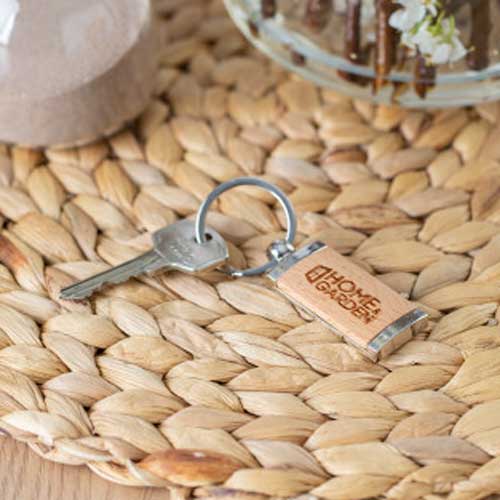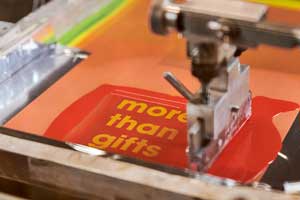What is a laser engraving machine?
Dazzle with millimeter-precision and professional laser engraving, creating detailed designs with impeccable finishes.
Leave a lasting and captivating mark on every piece of customized merchandise, showcasing your brand with style and elegance.
Laser printing is an ideal personalization technique to breathe life into your favorite objects. Due to its versatility, it can be applied to products made of primarily metal, wood, glass, and leather.
The color laser engraving stands out for its elegant and long-lasting finish, conveying an image of professionalism and quality. Unlike other techniques such as screen printing or pad printing, laser engraving offers greater durability, ensuring that the design remains intact over time.
Personalization is achieved through a laser head that marks the product's surface, resulting in a very precise and detailed outcome.
It is a versatile marking technique because it can be applied to surfaces of various materials, and you will achieve a well-appreciated detail for gifting due to its high-quality finish.
What does a laser engraver do? Which the types of laser engraving
Laser engraving is surprisingly versatile, allowing you to personalize and decorate a multitude of materials. With its wide range of types, you can create unique and detailed effects on different surfaces. It is famous for bijoux, as a jewelry laser engraver. Discover below the endless creative possibilities it offers to add value and distinction to your products and designs.
Embossed laser engraving
Allows for the creation of visual effects through precise laser control. The heat generated by it selectively burns or vaporizes the material, creating textures and reliefs on surfaces such as wood, acrylic, and leather.
Its finish is a tactile engraving that adds realism to designs. It is used in the manufacturing of luxury products, decorative items, and artisanal work.
Fusion laser engraving
The laser generates enough heat to melt or fuse the material, creating permanent marks on its surface. It is used on metals, plastics, and other materials, being especially useful for customizing items like jewelry, plates, or labels.
Depending on the material used, different visual effects can be achieved.
Oxy-fuel laser engraving
Oxy-fuel engraving combines the power of the laser with a stream of oxygen to achieve precise cuts and engravings on metallic materials. The laser provides the necessary energy to melt the material, while the controlled flow of oxygen removes the residue and allows cutting through the piece.
This technique is widely used in the metallurgical industry, as it enables the creation of complex and detailed pieces with great precision and quality.
Laser marking
Involves creating permanent marks on the material's surface without removing additional material. It is used on various materials such as metals, plastics, ceramics, and glass. It is common in the industry for marking barcodes, serial numbers, logos, or other identifying data on products and components.
Thanks to its accuracy and durability, it ensures excellent legibility and resistance to abrasion.
Surface laser engraving
Allows for high-resolution engravings on the material's surface. The laser burns or marks the material without penetrating it, generating precise and defined details.
It is ideal for creating intricate designs on paper, cardboard, business cards, glass, or similar materials.
Deep laser engraving
This method is perfect for creating greater depth in materials like wood, acrylic, and plastic. The laser penetrates the material and can create three-dimensional designs on thicker pieces.
It is used in the manufacturing of trophies, decorative elements, and industrial applications where greater engraving depth is required.
It is important to note that some types of laser engraving can overlap or be combined depending on the project's needs and characteristics. Additionally, the materials used and laser settings can influence the final results of laser engraving.
How laser engraving works
Personalization with laser engraving is carried out using a machine that emits a laser beam that burns the product's surface to engrave the design. Depending on the material, the laser engraving finish will differ, as the result varies, for example, between wooden keychains or engraved pens.
Design preparation
First, the design to be engraved must be created. This can be a logo, text, or any other element you want to engrave on the material.
It is important to vectorize it and leave it in a single color to ensure optimal results on the final product. This ensures that the details are reproduced with clarity and sharpness during the process.
Parameter configuration
Once the design is ready, the laser parameters are configured based on the material's characteristics. This includes laser power, movement speed, pulse frequency, among other settings.
These parameters depend on the type of material, its thickness, and the desired engraving depth or intensity.
Material placement
The material to be engraved is placed on the laser machine's work surface. It is properly secured to prevent movements or displacements during the engraving process.
Start of engraving
Once the parameters have been established and the material positioned, the engraving process begins. The laser is focused on the specific area where engraving is desired and is activated.
The laser beam interacts with the material, either by removing surface layers, sublimating pigments, or creating reliefs, depending on the type of laser engraving used.
Process control and monitoring
During engraving, it is important to monitor and control the process to ensure the desired result is achieved. This involves supervising the engraving quality, the speed of advancement, the engraving depth, and other key parameters. If necessary, real-time adjustments can be made to obtain the best possible result.
Completion and finishing
Once the engraving is complete, the material is removed from the laser machine. Depending on the type of engraving and the material used, some additional processes may be required, such as cleaning, polishing, or the application of protective coatings to enhance the appearance and durability of the engraving.
The laser printing machine is highly effective because it allows the same design to be repeated multiple times while maintaining the same shape, intensity, and width of the laser engraving.
What can a laser engraver do? Pros and cons of laser engraving
This technique is widely used in product personalization due to its numerous advantages and high-quality final results.
Final result
The final result of the design is quite precise, as small details are well defined. With the laser, you achieve an elegant and attractive result, making it the ideal technique if you want your brand to be associated with a luxury and professional image.
Price
This technique is not as expensive as it may seem. In the past, machines were not as advanced, and customizing with engraving was costly in terms of effort and cost, but today it is a technique that allows for both small and large runs at a reasonable price.
Durability
Its durability surpasses that of other techniques, as the engraving will not fade or deteriorate with product use, making it the perfect choice if you want your design to last forever.
As for the cons:
Color
The laser has no color. The engraved result will have the color of the material after the first layer is eroded. For this type of technique, we have special laser promotional mugs that, when engraving the logo on the outer white layer, display a different inner color.
Material limitations
Laser engraving works best on materials such as metals, plastics, woods, and some types of leather. Some softer or delicate materials may be damaged or not achieve an optimal result.
Engraving size
Laser engraving machines have limitations in terms of the size of the piece that can be engraved. This can be a restriction if large objects or high volumes need to be engraved.
Differences between laser engraving and laser marking
Laser engraving and laser marking are two different but related techniques used to create marks, designs, or information on various materials. Below are the key differences between them:
Laser Engraving
Physical or chemical removal of material to create durable marks on the object's surface.
Uses a highly concentrated laser beam that burns or vaporizes the material, leaving a visible and permanent mark.
Commonly used on wood, acrylic, metal, glass, and stone.
Allows for precise control of engraving depth, offering the possibility of creating relief effects or subtler engravings.
Laser Marking
Laser marking involves altering the material's surface without removing any layers or parts of it.
Uses the laser beam to change the color, texture, or appearance of the material without affecting its internal structure.
Used for surface marks on plastic, metal, paper, leather, ceramics, among others.
Precise and permanent technique that provides high legibility without compromising the material's integrity.
In summary, laser engraving and laser marking are two different yet related techniques for creating marks on various materials. While laser engraving removes material to create lasting marks, laser marking alters the surface without affecting the internal structure. Both techniques offer precise and permanent results, providing a wide range of possibilities in different materials.
What to laser engrave? Best products to personalize with laser engraving
Before choosing, it is essential to consider the material and surface of the product, and what can you engrave with a laser engraver. In this case, wood and metal are excellent options for customizing with this technique. Laser engraving offers endless possibilities for personalizing unique gifts. So, what can I laser engrave?

Wooden Keychains
Wooden keychains are excellent for laser engraving. Their natural and warm texture creates a unique contrast with the engraving, providing a handmade and personalized look.
Additionally, wood's durability ensures that the engraving remains intact even with daily use, making it a quality promotional gift.

Customized Thermos Bottles
Laser engraving finds a perfect canvas in aluminum bottles. Their smooth and glossy surface creates a great contrast with the engraving, highlighting the details. Furthermore, their resistance to wear ensures that the design lasts over time.
What is the cost of laser engraving a promotional item?
The costs associated with laser engraving are not as high as one might think. In fact, it is a more cost-effective alternative than screen printing and pad printing, especially when printing multi-color designs.
The price varies depending on factors such as size, design complexity, item material, quantity of units, and service provider. In general, laser engraving is an affordable option that delivers excellent results in personalizing promotional products, conveying an image of elegance and quality.
Conclusions
As we've seen, laser engraving is the perfect choice for those looking to personalize promotional gifts with precision and style. This technique offers exceptional versatility, creating detailed and high-quality designs on a wide variety of materials, from metal and wood to plastic and glass.
With laser engraving, you can enjoy numerous advantages, such as wear resistance, the ability to create relief effects, and the ability to print custom designs with great precision. Whether engraving names, logos, or personalized messages, it offers the opportunity to create unique pieces that reflect the dedication and care of those who give them.
When it comes to standing out in the world of merchandising, laser engraving is an ideal option for adding value and originality to products, leaving a lasting impression on your customers or employees.


